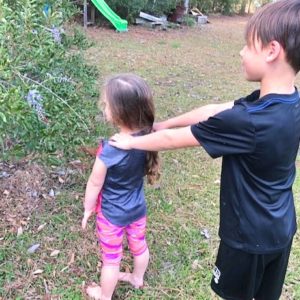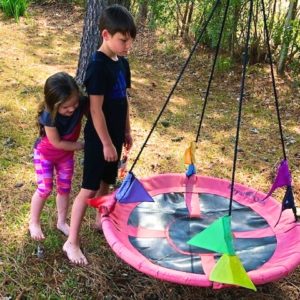
Backyard Fun for Kids and Families

Spring is here and, now more than ever, it’s time to break out of the house for backyard family fun. If you and your kids are tired of being cooped up, we’ve got ideas to help you take it outside. At TreeRush, we are all about outdoor adventure and our TreeRush staff have led outdoor team building programs with youth and adults for years. We sorted through our files and chatted with some friends to find three gems. Bring on some friendly competition, plot together to meet a goal and discover hidden backyard wonders.
You can relate these fun backyard activities to educational objectives, make them a life-skill lesson, burn off some energy, or add some laughter to your day. Parents, we dare you to join in the action!
Moonball
(Bottomless Bag by Karl Rohnke)
Playing Moonball requires a beachball. Or, if you don’t own one, the kids can make a “trashball” as suggested by Chris Cavert from FUNdoing. To do this, wad up newspapers (or plastic bags) to create a ball that’s about 20 inches in diameter and wrap masking tape around it. Voila! You’ve got an airy ball that moves in unpredictable ways.
Once you have a ball, it’s game time. Gather your people and try to strike the ball as many times as you can without letting the ball touch the ground. As you play, let the rules evolve. For example:
- Maybe a hand tap equals one point.
- Maybe a foot strike equals two points.
- You might decide to ONLY allow foot strikes.
- How many points for a header or an elbow strike?
- Do you get more points if you hit the ball with a foot while doing a handstand?
- Set goals for the number of strikes you’d like to reach as a group.
- You can make racking up points more difficult if you start each round by making sure everyone in the group strikes the ball once before someone in the group can strike it again. (For example, in a 5-person group, the person striking the ball second can’t also strike it third, fourth or fifth.)
- Get creative and add more props if you have them. Bring out a hula-hoop and any strike sending the ball through it means bonus points.
When you play Moonball, please take videos. We’d love to see your clips of this game on our Facebook Page!
Rock, Paper, Scissors, Splitz
(Michelle Cummings, of Training Wheels: A Creative Resource for Building Teams)
Rock, Paper, Scissors provides a walk down memory lane. We bet you played this game as a kid. If you didn’t, here are the basics. Two people face off and pound one of their fist into their other hand three times saying, “One. Two. Three.” Then, instead of saying “four” players say “show” and each person chooses to make one of three “signs” with his or her pounding hand. For this game, “rock” is a fist; “scissors” is a sideways peace sign; and “paper” is a flat hand. If both players “show” the same sign, the round is a tie. Otherwise:
- Rock beats scissors and wins
- Scissors cut paper and win
- Paper covers rock and wins
You might want to play a couple rounds of Rock, Paper, Scissors as a refresher. Then, introduce the added challenge of SPLITZ. Here’s how to do it:
- The two players face each other and their right toes touch. Each places their left foot behind the heal of their right foot.
- Play a round. The winner moves his or her front foot so that it touches the heal of his or her back foot. The loser slides his or her front foot forward.
- Play another round. The winner moves his or her front foot so that it touches the heal of his or her back foot. The loser slides his or her front foot forward.
- Repeat these steps until one person falls over or can’t continue.
This challenging no-prop game will become a favorite. For clarification, find a video by clicking here.
Human Camera
(Silver Bullets by Karl Rohnke)
In order to play Human Camera, two people work together to take “pictures.”  One person is the “camera” and the other is the “photographer.” Be forewarned, you may want to talk about trust before starting this activity. Trust can be hard to build and easy to break. For this discussion, be ready with examples what your kids do every day to show you can trust them and that they can trust each other. If one of your kids is a bit of a jokester, you might want to think about asking him or her to be your “camera” so you can be a model “photographer.”
One person is the “camera” and the other is the “photographer.” Be forewarned, you may want to talk about trust before starting this activity. Trust can be hard to build and easy to break. For this discussion, be ready with examples what your kids do every day to show you can trust them and that they can trust each other. If one of your kids is a bit of a jokester, you might want to think about asking him or her to be your “camera” so you can be a model “photographer.”
After a brief trust chat, introduce the activity by explaining a camera is like the human eye. For example, when you push a button on a camera, the shutter opens like an eye and captures an impression. Then, when the shutter closes, it is like a closed eye.
 During the activity, the “photographer” can see, and the “camera” closes his or her eyes. The “photographer” is responsible for finding an interesting image. To do this, the “photographer” guides the “camera” while exploring the backyard for a good picture. This picture, for example, could be a close-up of a bug or a flower bud. On the other hand, the “photographer” may want to capture a picture of a far away bird. Once the “photographer” finds the perfect image, he or she adjusts the “camera” for the perfect view and says, “click.” At that point, the “camera” opens its shutter/eyes for about three seconds to mentally record the image. The “photographer” gets three opportunities to treat the camera to something special. Once three pictures are taken, switch roles. The “camera” is now the “photographer.”
During the activity, the “photographer” can see, and the “camera” closes his or her eyes. The “photographer” is responsible for finding an interesting image. To do this, the “photographer” guides the “camera” while exploring the backyard for a good picture. This picture, for example, could be a close-up of a bug or a flower bud. On the other hand, the “photographer” may want to capture a picture of a far away bird. Once the “photographer” finds the perfect image, he or she adjusts the “camera” for the perfect view and says, “click.” At that point, the “camera” opens its shutter/eyes for about three seconds to mentally record the image. The “photographer” gets three opportunities to treat the camera to something special. Once three pictures are taken, switch roles. The “camera” is now the “photographer.”
When the activity is done, it can be fun to talk about it. First, let everyone describe their favorite picture. What was fun about being the photographer? What was fun about being the camera? When you were the camera, what did you like about your photographer? As the camera, what were your thoughts or feelings? When you were the photographer, what were your thoughts or feelings? How did this impact the experience of your camera?
If you’d like, take this activity a step further. For example, you can break out colored pencils draw favorite images captured by each “camera.” As an alternative, use a cell phone to take actual pictures of the images captured in this activity and send these images as a gift to friends or family members.
Additional Resources
Need help for teaching kids at home? Check out our previous blog by clicking here.
Check out FUNdoing for adventure-based activities. The site is stuffed with ideas used by teachers and people who lead team development programs. Because more parents are becoming teachers due to the Covid-19 outbreak, FUNdoing is add resources for families
Find game ideas, books of great activities and awesome supplies, gizmos and gadgets at the Training Wheels or the Fun Doing websites. You’ll find resources for teaching, for exploring nature, and for providing team development to youth and adults.
Post written by Kema Geroux

